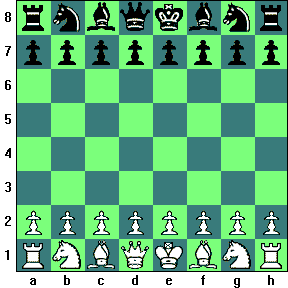|
Turn your knowledge of chess into a profitable business with Site Build It An Introduction To Chess...Chess is a wonderful board game, invented thousands of years ago. Throughout its long history, it has earned noticeable acknowledgement and is considered to be the 'king' of board games. Nowadays, chess stills attracts people from all over the world, regardless of their age. Chess is fascinating because it allows players to put their technique, experience and inspiration into rivalry. 
Your goal is to trap the enemy King - it's that simple...The chessboard is a 8x8 board with alternating black and white squares; everybody is sure to have seen one. The chess pieces are 32 in total; 16 white pieces and their 16 black counterparts. One player owns the white pieces (we call this player WHITE) and his opponent (the BLACK) gets the black ones. The 16 pieces are : the King, the Queen, two Rooks, two Bishops, two Knights and eight Pawns. When the game starts these pieces are placed in their initial positions, which are predefined. This initial arrangement is as follows : each player has his own pieces positioned along the two ranks of the board that are closest to him. All 8 pawns are placed on the innermost rank of the two. The rest of the pieces are placed in the outermost rank in the following order : Rook, Knight, Bishop, Queen, King, Bishop, Knight, Rook. This order is from left to right for WHITE and from right to left for BLACK, so that same pieces are opposed on each file of the board. To facilitate descriptions of chess positions It is known as 'algebraic chess notation' (there is also the descriptive notation, which is quite obsolete). It is particularly easy to learn and helps us easily identify squares and pieces on the board. It works like this : viewing from WHITE's perspective, the leftmost file is named 'a', the next one is named 'b' and so on until we reach the rightmost file, which is file 'h'. Moreover, the rank that is closest to WHITE is 'rank 1', or the first rank. Next comes 'rank 2' (the second rank) and so on until we get to the eighth rank, which is the rank closest to BLACK. Now that we have appropriately named the ranks and the files we may identify a square by looking up the rank and the file to which it belongs. Thus, still viewing from WHITE's side, the bottom left square is the square 'a1', since it belongs to file a and to the first rank. Its adjacent squares are 'b1' on the right and 'a2' just above it. So we may repeat the initial position using chess notation :
Note that the chessboard should be so placed that the a1 square is black. To read the next article in this series, Basic Chess Moves, click here... An Introduction To Chess Sets looks at what types of chess sets are available Chess Tables looks at the different types and styles of chess table available Chess Clocks takes you through the use of chess clocks in the modern tournament game Is there room for a Chess Computer in your life. This article looks at the latest in chess computer technology The Chess Terms looks at many of the common (and uncommon terms of the game The Chess Tactics discusses why tactics are probably the most decisive aspect of the game of chess The Chess Openings looks at the first 10-15 moves which are said to constitute the 'opening' phase of the game The Chess Openings continues our look at the first 10 to 15 moves of your chess game The Chess Middle-game Part 1 looks at the strategies employed during the middlegame, which is the most complicated part of the game. All forces have been developed and are ready to fight for victory...you don't want to go wrong here... The Chess Middle-game Part 2 continues our look at the strategies employed during the middle part of the game of chess The Endgame In Chess Part 1 looks at how the game is won and several strategies you can employ to beat your opponent The Endgame In Chess Part 2 continues our look at the final stages of the game of chess The Endgame In Chess Part 3 wraps up the strategy and moves of the final stages of the chess game Special Chess Moves looks at several special moves and strategies. The moves described are only valid when no other piece is interfering. Hey did you know that you you could easily build a part of full time business out of your love of chess or maybe some other topic, hobby or pastime you love to do and are passionate about? You can you know. If you'd like to see how 6 real people just like you have created profitable online businesses that have given them freedom and a great lifestyle, check out our FREE 7 day Mini Course called How To Build The Perfect Home Based Business Around Your Favorite Hobby, Pastime, Sport Or Skill. It's easy to subscribe, just put your First Name and your Primary Email Address into the form below and click on the Free Instant Access button, that's all there is to it. Ok, here's the form... I hate Spam with a passion. Your email address is safe and will never be sold rented or given to anyone else without your permission We hope this guide to chess helps you to get more out of the game, and the Mini Course will give you lots of inspiring ideas on how you can turn your favorite hobby, skill or pastime into a profitable business if you've ever wondered what was involved in doing just that... We hope you enjoy reading through our chess tips and articles. Thanks for visiting,
This Is A Solo Build It Site, Powered Of Course, By Solo Build It
|




